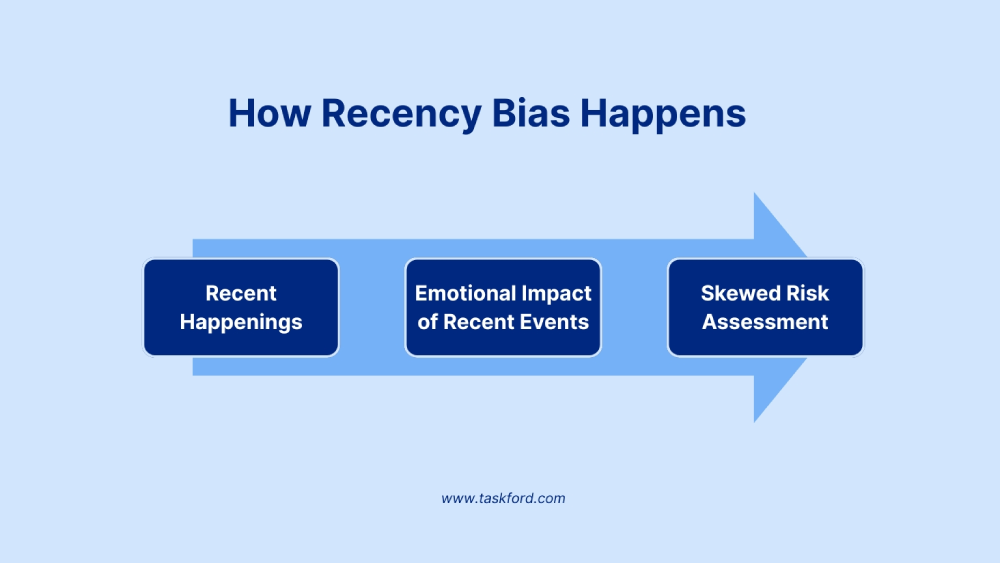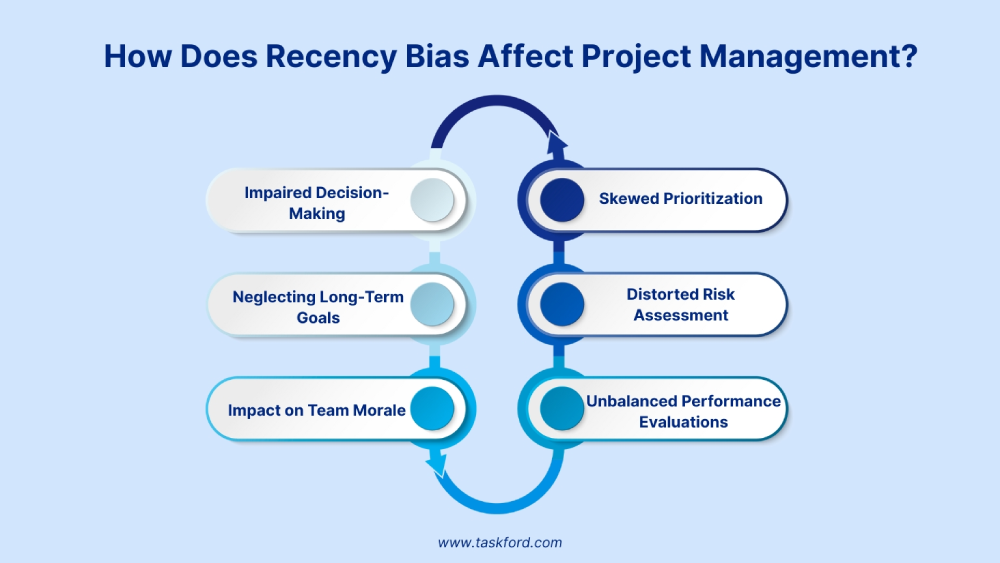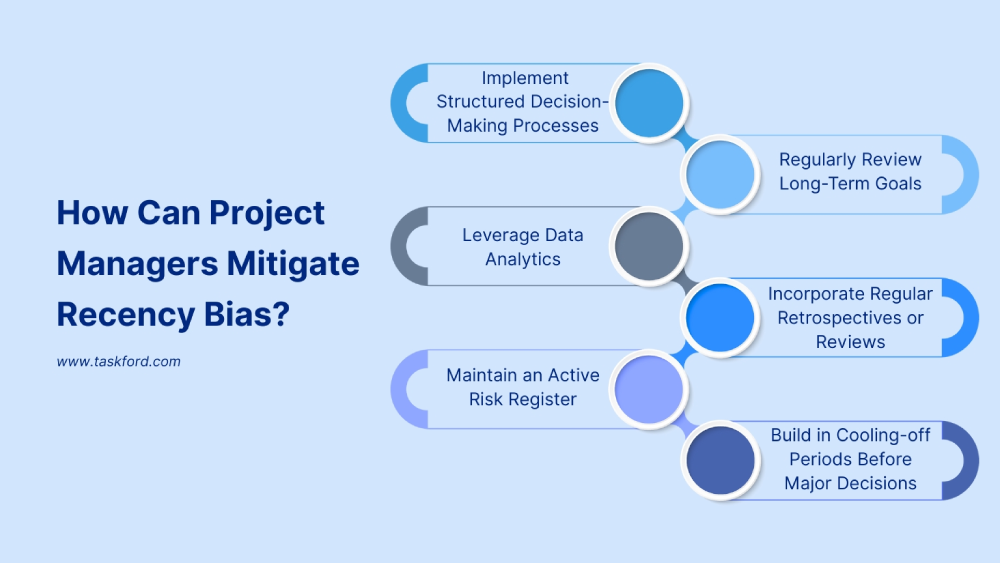Understanding Recency Bias in Project Management: FAQs and Expert Insights on Overcoming
Learn about recency bias in project management, its impact on decisions, and expert tips on overcoming it to ensure better project outcomes.
Project managers are no strangers to constant change and shifting priorities. Yet, one challenge that often goes unnoticed is recency bias – the tendency to focus more on recent information or events while disregarding older, but equally important, data.
When recent tasks, milestones, or team actions dominate the decision-making process, project managers can unintentionally overlook long-term trends, risks, and objectives. This can affect everything from planning and prioritization to team performance evaluations and risk assessments.
This blog will break down how recency bias shows up in project management, answer frequently asked questions, and provide expert advice on how to reduce its impact. By addressing recency bias head-on, project managers can enhance their decision-making process and keep their projects on the right track.
What is Recency Bias?
Recency bias is a cognitive phenomenon where people give disproportionate weight or importance to the most recent information or events they encounter, often at the expense of earlier, equally significant data. This bias stems from our natural tendency to focus on what is immediate and fresh in our memory, leading to the belief that recent events are more relevant, important, or impactful than past occurrences.
In project management, recency bias can cause managers to prioritize the most recent tasks, milestones, or performance reports, potentially overlooking earlier stages or broader project objectives. It can also skew how risks are assessed, with recent challenges or successes appearing more critical than long-term trends or historical project performance. When the present moment is overemphasized, project managers might make decisions that don’t fully account for the overall project, ultimately affecting its success.
Recognizing and addressing recency bias is essential for making balanced decisions that align with both immediate needs and long-term project goals.

Examples in Project Management:
- Overreacting to Recent Feedback: A project manager might shift resources to address a client’s latest complaint about a minor feature, neglecting critical tasks outlined in the project plan.
- Performance Evaluations: A team member’s recent mistake might overshadow their consistently strong performance during a review.
- Risk Management: Focusing only on a newly identified risk while ignoring previously documented risks that could have a greater impact.
How Does Recency Bias Affect Project Management?
Recency bias, the tendency to overemphasize recent events, can disrupt project management by skewing decisions and priorities. Here’s how it impacts projects:
- Skewed Prioritization: Recent tasks or issues may be prioritized over more critical, long-term objectives, leading to inefficiencies.
- Distorted Risk Assessment: Recent setbacks or successes can overshadow ongoing risks, misallocating resources or underestimating potential challenges.
Learn more: How to Use a Risk Assessment Matrix for Smarter Project Planning
- Unbalanced Performance Evaluations: Team members may be judged based on recent actions, ignoring their overall contributions, leading to unfair evaluations.
- Impaired Decision-Making: Decisions may be made reactively, based on the latest information, disrupting the project’s overall strategy.
- Neglecting Long-Term Goals: Focusing too much on the present can cause project managers to lose sight of strategic, long-term objectives.
- Impact on Team Morale: When recent performance is overemphasized, it can lead to frustration and decreased motivation among team members.

By recognizing and mitigating recency bias, project managers can make more balanced decisions and keep projects on track.
How Can Project Managers Mitigate Recency Bias?
To effectively manage recency bias, project managers can implement practical strategies that encourage thoughtful, long-term decision-making. Here are some steps to mitigate the impact of recency bias:
1. Implement Structured Decision-Making Processes
Adopt tools like SWOT Analysis and cost-benefit analysis to ensure decisions are not based solely on the most recent developments. These frameworks require a thorough review of both immediate and long-term factors, helping project managers make well-rounded decisions.
2. Regularly Review Long-Term Goals
It’s essential for project managers to frequently revisit the project’s long-term objectives. This can be done through quarterly reviews or by setting key project milestones. These reviews provide an opportunity to check if recent events have caused any shift in priorities and ensure the project remains aligned with its original vision.
3. Leverage Data Analytics
Use project management tools like TaskFord to visualize project trends and progress over time. This data-driven approach provides a broader view of the project, helping you make decisions based on overall trends rather than recent events.
4. Incorporate Regular Retrospectives or Reviews
Hold retrospectives or phase-end reviews that encourage reflection on the project’s history, not just recent accomplishments. This can be done after every sprint or project milestone, enabling the team to assess both past successes and challenges while identifying patterns that may affect future decisions.
5. Maintain an Active Risk Register
Continuously update the risk register with both new and old risks. Regularly review it with the team to ensure that no long-term risks are being overlooked in favor of reacting to recent problems. An updated risk register helps the team prioritize and address ongoing challenges more effectively.
6. Build in Cooling-off Periods Before Major Decisions
Introduce a cooling-off period (24-48 hours) before making significant project decisions. This allows time to process new developments and review both recent and historical data, leading to more thoughtful and balanced decisions.

By applying these strategies, project managers can reduce the influence of recency bias, ensuring that decisions are informed, balanced, and aligned with the project’s overall goals.
What is Recency Error, and How to Deal with it?
Recency error is another term for recency bias, specifically when it leads to mistakes in judgment or decision-making due to overemphasizing recent events. In project management, recency error might manifest as a manager overcorrecting based on a recent client critique or unfairly evaluating a team member based on their latest deliverable.
To deal with recency error, project managers should:
- Focus on comprehensive data analysis by tracking both recent and historical trends.
- Conduct regular retrospectives to review the project lifecycle and avoid impulsive reactions to recent changes.
- Promote a balanced perspective by involving multiple stakeholders in decision-making and encouraging long-term planning.
Frequently Asked Questions (FAQs) About Recency Bias in Project Management
Here are answers to common questions to clarify how recency bias affects projects and how to address it:
Q – How does recency bias affect project decision-making?
A – It drives reactive choices, like prioritizing a recent client request over planned deliverables, potentially causing delays or scope creep.
Q – Can recency bias impact team dynamics?
A – Yes, it can lead to unfair evaluations, like judging a team member on a recent mistake rather than their overall performance, which may lower morale.
Q – How can I spot recency bias in my work?
A – Look for signs like frequent plan changes based on new feedback or neglecting historical data. If decisions feel rushed, bias may be at play.
Q – What tools help combat recency bias?
A – Tools like TaskFord for visualizing project trends, Gantt Charts for timeline visualization, or risk matrices in Primavera help ground decisions in data.
Q – Is recency bias ever helpful?
A – In rare cases, like addressing an urgent crisis, it can prompt quick action. But it needs balancing to avoid derailing long-term goals.
Conclusion
Recency bias is a common challenge in project management, where recent events are given more weight than older, equally important data. This can lead to reactive decisions that undermine long-term goals, distort risk assessments, and skew performance evaluations.
By recognizing and addressing recency bias, project managers can make more balanced, informed decisions. Strategies like structured decision-making, regular reviews of long-term goals, and using data-driven tools can help mitigate its impact. Overcoming recency bias ensures projects stay aligned with both immediate needs and long-term objectives, leading to better outcomes and more effective project management.
Continue Reading
- Backlog Grooming: What Is It and Why It Matters in Agile
- Critical Path Calculator: How to Use It for Accurate Project Scheduling
- AI in Project Management: A Look at 2025 and Beyond
- Agile Project Management Software 5 Tools to Know
Subscribe for Expert Tips
Unlock expert insights and stay ahead with TaskFord. Sign up now to receive valuable tips, strategies, and updates directly in your inbox.